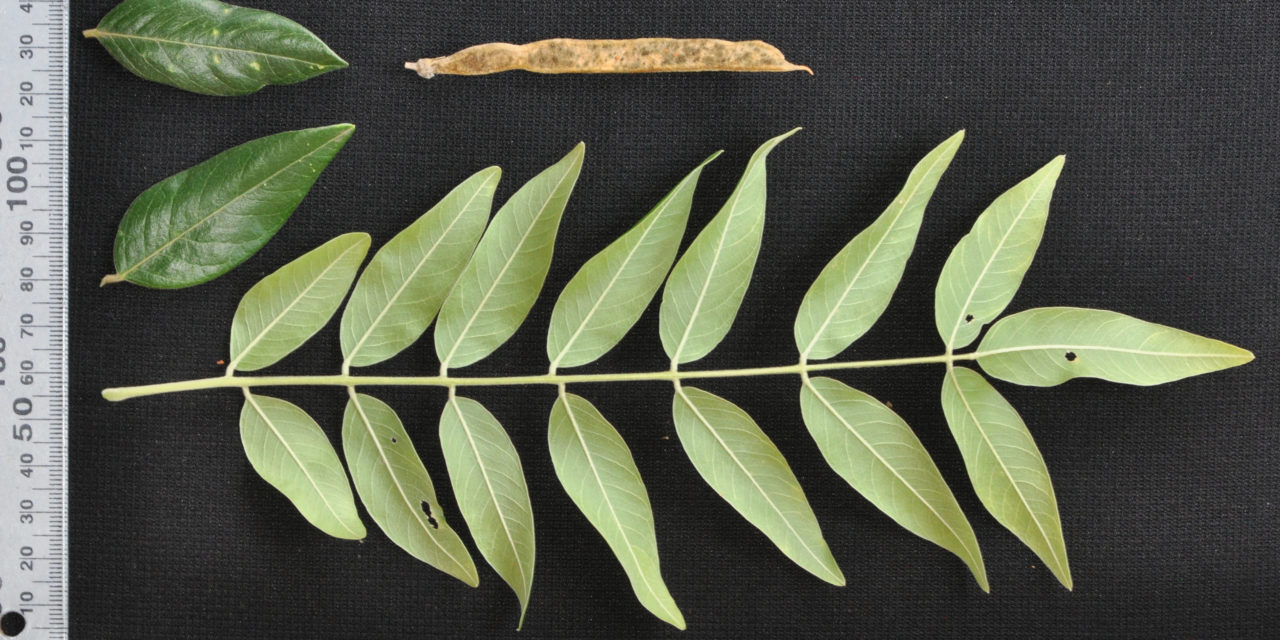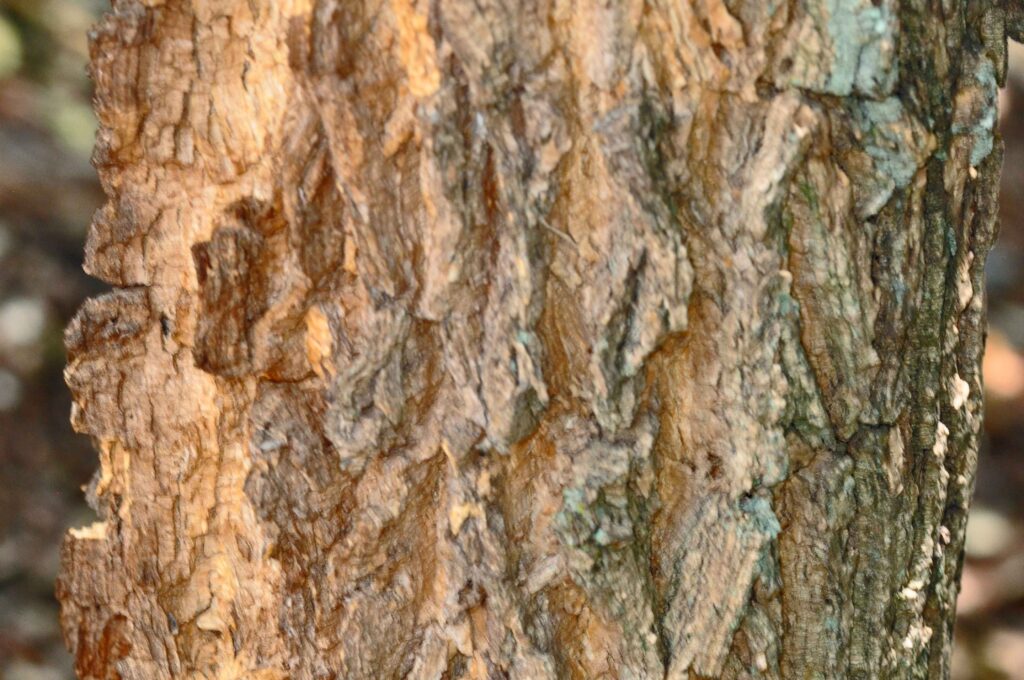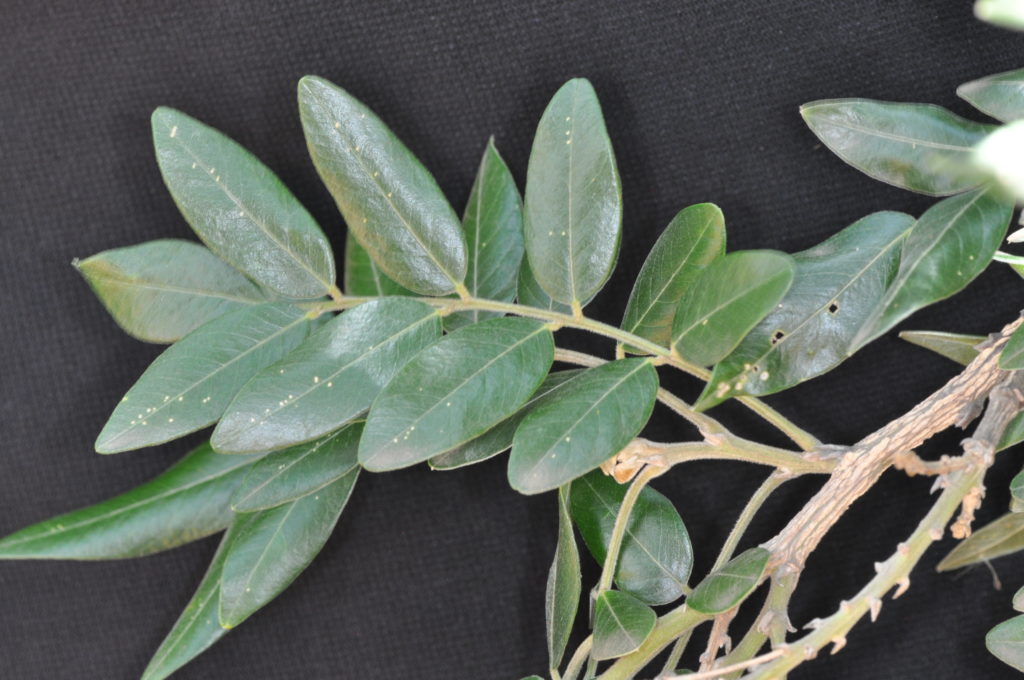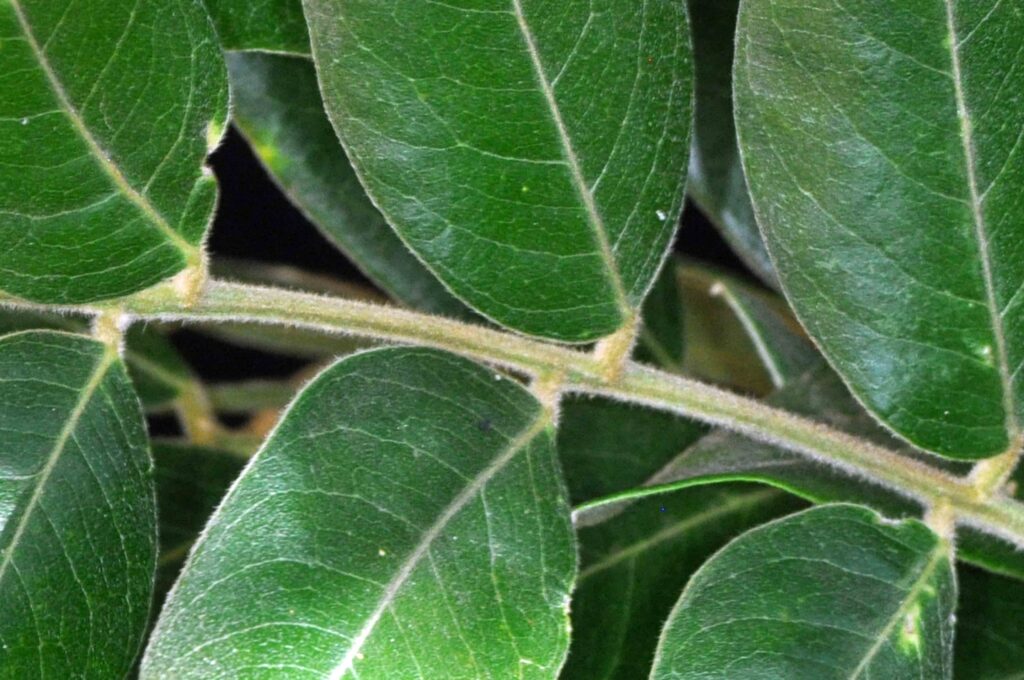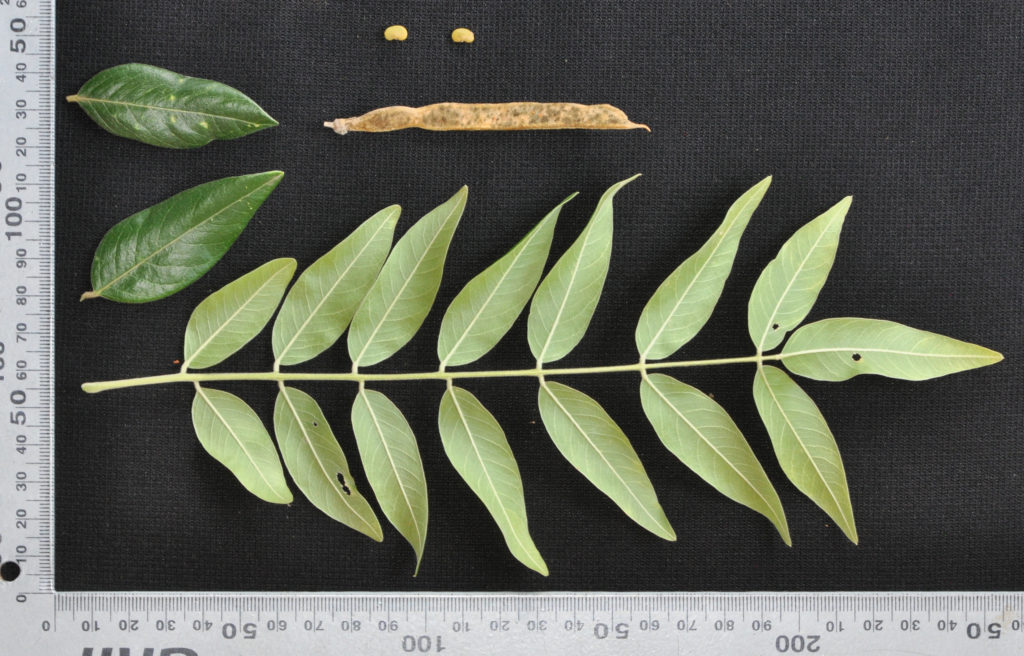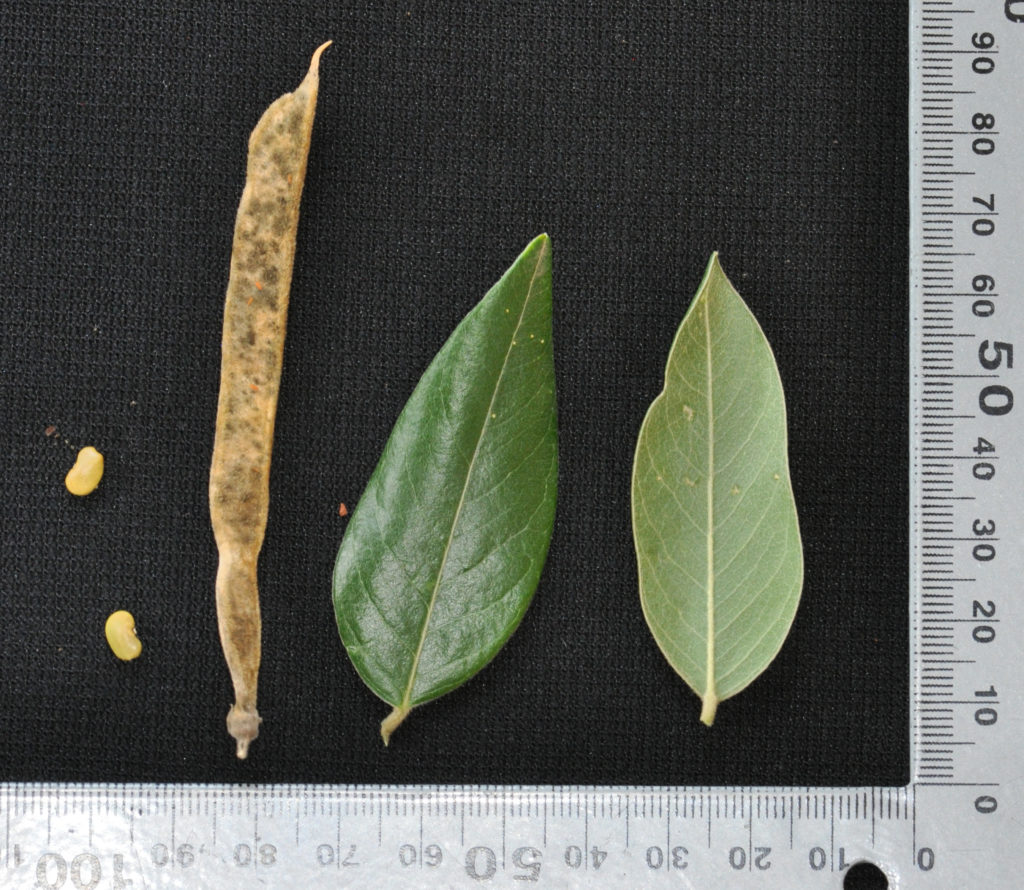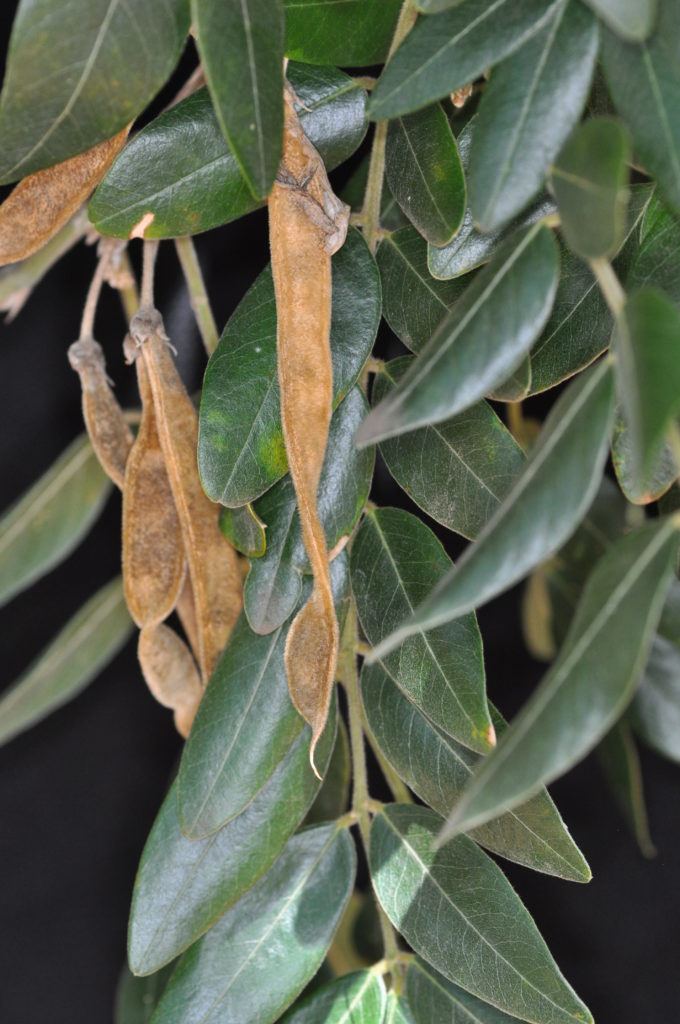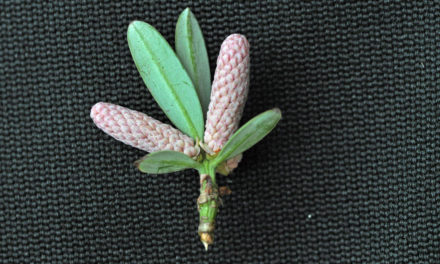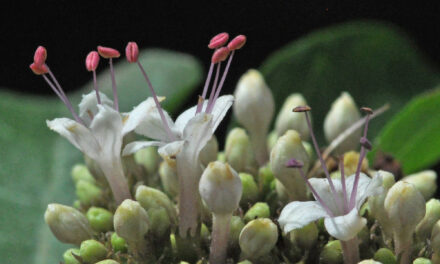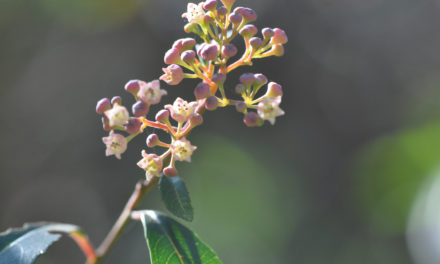General Info.
This Tree is usually up to 7m high. Bark becomes deeply furrowed and corky. Young branches have silvery white hairs. Alternate & imparipinnate Leaves have well-spaced leaflets with petiolules. Pea-like, bluish zygomorphic Flowers develop in racemes. 9 joined and 1 free stamens surround a pistil with an ovary having an incurved style and a capitate stigma. Fruit is a tardily dehiscent linear pod with reniform seeds.
Description.
Mundulea sericea.
Previous Names: Mundulea suberosa, Cytisus sericeus, Tephrosia suberosa.
SA Tree No. 226.
Common names: (Afr) Blou-ertjieboom, Blou-ertjieboom, Blou-ertjiebos, Kurkboom, Kurkboombos, Kurkbos, Olifantshout, Visboontjie, Visgif. (Eng) Cork Bush, Rhodesian Silver Leaf, Silver Bush, Silver Leaf. (isiZulu) Umamentabeni, Umhlalantethe, Umsindandlovu, Usekwane. (Northern Sotho) Mosita-tlou. (Setswana) Mohalakgôngwana, Mosikatsê, Mositatlou, Ntsandzandlopfu. (siSwati) Umsindzanlovana. (Tshivenda) Mukunda-ndou.
Family: Fabaceae or Leguminosae. (Pea, bean or legume family). After the Orchidaceae and the Asteraceae, the Fabaceae is the third largest Angiosperm (flowering plants) family with 700+ genera and close to 20 000 species. Local Tree genera on this website include Acacia (Vauchellia, Senegalia), Albizia, Bauhinia, Bolusanthus, Burkea, Calpurnia, Colophospermum, Cordyla, Cyclopia, Dichrostachys, Erythrina, Erythrophleum, Faidherbia, Indigofera, Mundulea, Peltophorum, Philenoptera, Piliostigma, Schotia and Xanthocercis. The Fabaceae are recognisable by their fruit and by their pinnately compound Leaves. Leaves may also be simple – even bilobed and usually have stipules – some of which may be spinescent. Leaflets are usually entire. Flowers are bisexual and bracteate. Regular flowers usually have 4-5 sepals and the same number of petals. Irregular flowers have 4-5 sepals and 5 or less petals. Stamens have anthers that have 2 pollen sacs and there are usually at least twice the number of stamens as petals – often 10. The superior Ovary has one locule that may contain 1 or more ovules. The Stigma and Style are simple. The single carpel develops into the Fruit, which is usually a pod. This pod dehisces on both sides and may break into segments. Seeds vary.
Name derivation: Mundulea – neat, elegant, or named after Johannes Ludwig Leopold Mund (1791-1831). He was a collector and land surveyor. He and his wife (a qualified physician) arrived in Cape Town in 1816 and he died there in 1831. sericea – silky: referring to the hairs on the leaves. Mundulea sericea is the only species in southern Africa. All the remaining species are in Madagascar.
Conservation: National Status: L C (Least Concern). Assessment: 2005 (W. Foden and L. Potter).
Tree
This plant may be a large woody shrub or a medium sized, tough Tree, usually up to 7m high but may reach 12m. The single stem has smooth young branches covered with silvery white hairs. The tough branches bend like a whip and are difficult to break with bare hands. As it ages, the pale rough and deeply furrowed Bark becomes very corky (photo 291). The Crown is much branched.
- 291 2016/01/26 Pretoria NBG. Photo: David Becking.
Leaves
On this usually evergreen plant, the soft, shiny Leaves are up to 14cm long and have a pale green, grey or silver (due to hairs) appearance. They differ quite a bit, are up to 25cm long and imparipinnate (pinnately compound leaf ending in a single leaflet – photo 300). The alternate leaves (photo 294) have 4-11 pairs of well-spaced, opposite, or nearly so, Leaflets and the single terminal one. The leaflets are up to 6,5 x 2,5cm and are ovate (egg shaped), elliptic or lance shaped. They are widest below the middle. The Margin is entire (with a continuous margin, not in any way indented). The Rachis (main axis bearing flowers or leaflets) is hairy and grooved along the top (photo 292). Veins are sunken above and protrude below (photo 300). The Apex is slightly attenuate (showing a long gradual taper of base or apex). The Base is rounded to broadly tapering. The Petiole (leaf stalk) is up to 3cm long. Stipules (basal appendage of the petiole) are small and subulate (a part that is slender and tapering to a point). Petiolules (stalks of leaflets – photo 292) are swollen and hairy and up to 3mm long.
- 294 2016/01/26 Pretoria NBG. Photo: David Becking.
- 292 2016/01/26 Pretoria NBG. Photo: David Becking
- 300 2016/01/26 Pretoria NBG. Photo: David Becking.
Flowers
The typical pea-like Flowers occur at the ends of branches and are mauve, violet or pink and occasionally white, and usually appear with new-leaves. They occur in terminal Racemes (simple elongated inflorescence with stalked flowers that open in succession towards the apex) that are up to 14cm long. Individual flowers have small bracts, are bisexual and zygomorphic (floral parts are unequal in size or form so that the flower is capable of division into essentially symmetrical halves by only one longitudinal plane passing through the axis). The Calyx is bell-shaped and has a hairy exterior. The Corolla is made up of 5 Petals: the uppermost is the Vexillum or Standard petal which is externally silky. Below this, on each side, are the 2-sickle shaped to oblong Wing petals. Finally, the 2 joined, lowermost petals make up the Keel. These joined petals are gibbous (swollen or bulging on one side) and are individually similar to the wing petals. The keel petals surround the 10 uniform Stamens – 9 of which are joined and the tenth, which is dorsally situated below the vexillum, is free. The Anthers are uniform. There is a single Pistil (a unit of the Gynoecium, the female element of the flower, composed of the Ovary, Style and Stigma) and the subsessile linear Ovary contains a number of ovules. The incurved Style ends with a small capitate Stigma. (Oct-Feb).
Fruit
The linear (long and slender) Fruit is a brown or yellowish grey, flattish Pod (a dry, dehiscent fruit – photo 301). It is up to 12 x 1cm with a marked yellow-brown rim and may be constricted between seeds. It is initially velvety golden-brown and ages to grey. A persistent Calyx and Stigma are visible (photo 301). The tardily dehiscent pods may remain on the tree for months. Seeds are reniform (kidney-shaped – photo 296) and up to 7 x 4mm. (Nov-Apr).
- 296 2016/01/26 Pretoria NBG. Photo: David Becking.
- 301 2016/01/26 Pretoria NBG. Photo: David Becking.
Distribution & Ecology
Mundulea sericea is a survivor. This plant coppices (young tree stems are repeatedly cut/burned down to near ground level which may cause regrowth from the stump or roots) well. Indigenous locations are in KwaZulu-Natal, Limpopo, Mpumalanga including Kruger, Gauteng and North West. It also occurs in Mozambique – widespread – especially in the north, Botswana, Zimbabwe, Tanzania, Namibia e.g. Etosha Pan, Angola, Somalia, Madagascar, India and Sri Lanka. The tree in common in savannah (a rolling grassland scattered with shrubs and isolated trees, which can be found between a tropical rainforest and desert biome) and on koppies (small, natural hills rising up from the African veld). Occasionally it occurs near rivers. These plants usually occur below 1 900m and are common in sandy soil. The tough Bark helps it survive veld fires which may cause the bark to turn black. Butterfly larvae of the Common Zebra Blue (Leptotes pirithous pirithous) feed on the Flowers and immature Seeds. This butterfly occurs in Africa, Madagascar, southern Europe and Asia. This plant supplies larval food for the Natal Silverline butterfly (Cigaritis natalensis). Sunbirds are attracted to the Flowers. Bees and Carpenter Bees are agents of Pollination. Elephants, impala, giraffe and eland browse the leaves.
Ethnobotany
Wood has an unpleasant smell when cut, but it is tough, hard and strong. Bark and roots can be used as an insecticide. They may even be used to poison crocodiles. Roots, bark and seeds are used to poison fish but do not seem to effect grazing animals. Cooking the fish rids it of the poison which contains Rotenone, an insecticide (), which is found in many roots including Mundulea sericea. It also kills spiders. Other rotenoids including deguelin and tephrosin are present in this plant. Side effects on mammals are small. Domestic animals eat the Leaves. This tree is easy to Grow from seeds which should be soaked in hot water before planting. They do best in well-drained soil. The tree is hardy, slows growing and has attractive silvery leaves and flowers. The roots are non-aggressive. The plant is used in bonsai and local medicine.
References
Boon, R. 2010. Pooley’s Trees of eastern South Africa. Flora and Fauna Publications Trust, Durban.
Burrows, J.E., Burrows, S.M., Lotter, M.C. & Schmidt, E. 2018. Trees and Shrubs Mozambique. Publishing Print Matters (Pty) Ltd. Noordhoek, Cape Town.
Coates Palgrave, M. 2002. Keith Coates Palgrave Trees of Southern Africa, edn 3. Struik, Cape Town.
Foden, W. & Potter, L. 2005. Mundulea sericea (Willd.) A.Chev. subsp. sericea. National Assessment: Red List of South African Plants version 2020.1. Accessed on 2022/03/21.
Lawrence, G. H. M, 1951. Taxonomy of Vascular Plants. The Macmillan Company, New York. Tenth Printing 1965.
Palmer, E. & Pitman, N. 1972. Trees of southern Africa, Balkema, Amsterdam, Cape Town.
Schmidt, S. Lotter, M. & McCleland, W. 2002. Trees and Shrubs of Mpumalanga and the Kruger National Park. Jacana, Johannesburg.
van Wyk, B. & van Wyk, P. 1997 Field guide to Trees of Southern Africa. Struik, Cape Town.
Woodhall, S. 2020. Field Guide to Butterflies of South Africa, edn 2. Donnelley, RR, China.
http://www.plantzafrica.com/plantklm/munduleasericea.htm
http://www.zimbabweflora.co.zw/speciesdata/species.php?species_id=130100w
https://plants.jstor.org/stable/10.5555/al.ap.person.bm000125930
https://en.wikipedia.org/wiki/Leptotes_pirithous

